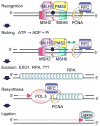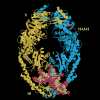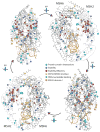DNA mismatch repair: molecular mechanism, cancer, and ageing
- PMID: 18406444
- PMCID: PMC2574955
- DOI: 10.1016/j.mad.2008.02.012
DNA mismatch repair: molecular mechanism, cancer, and ageing
Abstract
DNA mismatch repair (MMR) proteins are ubiquitous players in a diverse array of important cellular functions. In its role in post-replication repair, MMR safeguards the genome correcting base mispairs arising as a result of replication errors. Loss of MMR results in greatly increased rates of spontaneous mutation in organisms ranging from bacteria to humans. Mutations in MMR genes cause hereditary nonpolyposis colorectal cancer, and loss of MMR is associated with a significant fraction of sporadic cancers. Given its prominence in mutation avoidance and its ability to target a range of DNA lesions, MMR has been under investigation in studies of ageing mechanisms. This review summarizes what is known about the molecular details of the MMR pathway and the role of MMR proteins in cancer susceptibility and ageing.
Figures



References
-
- Acharya S, Foster PL, Brooks PJ, Fishel R. The coordinated functions of the E. coli MutS and MutL proteins in mismatch repair. Molecular Cell. 2003;12:233–246. - PubMed
-
- An Q, Robins P, Lindahl T, Barnes DE. 5-Fluorouracil incorporated into DNA is excised by the Smug1 DNA glycosylase to reduce drug cytotoxicity. Cancer Research. 2007;67:940–945. - PubMed
-
- Annett K, Duggan O, Freeburn R, Hyland P, Pawelec G, Barnett Y. An investigation of DNA mismatch repair capacity under normal culture conditions and under conditions of supra-physiological challenge in human CD4+T cell clones from donors of different ages. Experimental Gerontology. 2005;40:976–981. - PubMed
Publication types
MeSH terms
Substances
Grants and funding
LinkOut - more resources
Full Text Sources
Other Literature Sources
Medical

